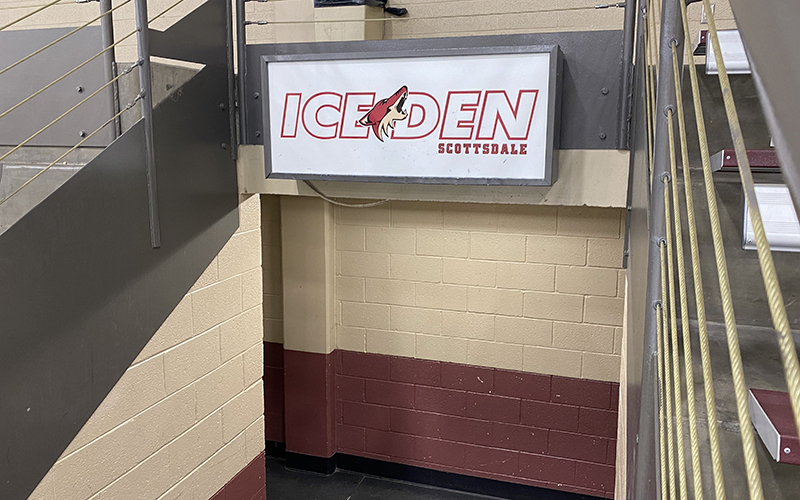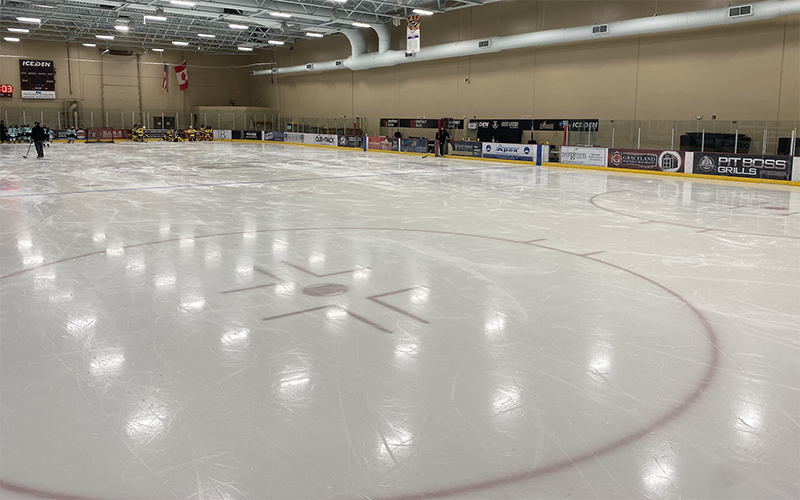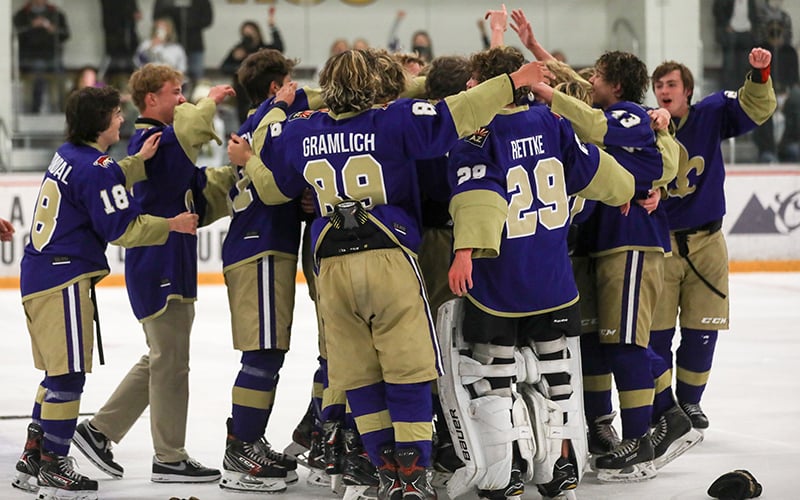PHOENIX – Arizona might not be a hockey hotbed yet, but the number of players the state produces is on the rise, including a handful of NHL standouts and prospects.
Homegrown players such as Auston Matthews of the Toronto Maple Leafs (2016), the Buffalo Sabres’ Tage Thompson (2016), Toronto’s Matthew Knies (2021), Josh Doan of the Arizona Coyotes (2021) are among the Arizona-born players drafted in the first and second rounds of the NHL Entry Draft in recent years.
It’s evidence that Arizona’s youth and high school hockey programs are thriving, despite a lack of available ice rinks or sanctioning by the Arizona Interscholastic Association, the governing body of Arizona high school sports.
Instead, future NHL prospects are emerging from the independent Arizona High School Hockey Association (AHSHA) and the Arizona Hockey Union (AHU), an organization of youth travel teams.
And they’re attracting record participation numbers.
According to a USA Hockey report for 2021-22, Arizona had 9,232 youth hockey players registered compared to 7,781 in 2016-2017 – that marks an 18.6% increase over five years. The number includes boys and girls who play in youth leagues, for high school teams or in organizations such as the Coyotes-sponsored Arizona Kachinas, a girls hockey program.
This season, the AHSHA has 768 players on 40 teams across several divisions representing 14 schools. There are teams across the Valley, in Tucson and in Flagstaff. Last season the AHSHA had 692 players, so it has experienced growth of about 11% just in the last year.
That has been the trend.
“Starting in 2016 we had 32 teams,” said AHSHA board member Jim Hertle. “We’ve seen a 25% increase in the number of teams, and it’s probably proportional to the number of players per team, which is usually between 17 and 20.”
Despite hockey’s growth and popularity, the sport remains outside of the AIA’s umbrella.
To become an AIA-sanctioned sport, a group representing the sport – usually a conference committee – must go before the AIA’s executive board and make a formal proposal as a board agenda item.
That has yet to happen with hockey.
“Folks have talked about hockey, but there really hasn’t been a big push to make it an AIA sport yet,” said AIA Director of Sports Information Seth Polansky. “The AIA doesn’t actively go out and add sports as its executive board is tasked with making these decisions. And if the board decides a sport is worthy of being brought into the association’s oversight, then we will start the administration process. (Hockey) needs a lot of resources behind it and a group that believes in it.”
For the time being, AHSHA continues to run independently of the AIA and has found success that way.
“Of course, it would be nice to have official affiliations with schools, and then you could be talking about getting these kids involved with, like, pep rallies or student yearbooks,” said AHSHA board member Jon Shivener. “But a lot of these kids are coming from a school that they’re not actually wearing on their jersey. I don’t think we would be able to sustain the number of teams that would be required in order to have an official affiliation.”
Even without an AIA affiliation, the sport is booming in popularity among high school kids.
Shivener said there are positives to remaining unaffiliated with the AIA, including the league’s ability to operate its governing board that is independent of the high school association.
“We’re allowed to make our own decisions that we think are best to face unique challenges specific to hockey,” he said. “It allows us to be inclusive to every kid that plays regardless of where they go to school.
“So in a sport that’s still in the process of growing and has a long way still to go, not having that freedom, flexibility, and inclusiveness would probably make it tougher if we were officially a part of the AIA.”
One of the biggest issues the AHSHA struggles with is ice time and with the staggering growth in participation, it is likely to become an even bigger problem. There are more than 4.8 million people living in the Phoenix Metropolitan area, according to the 2020 U.S. Census.
And interest in hockey is growing throughout the western U.S.
“We have far more playing hockey here than what those (ice) sheets can accommodate,” said Kenny McGinley, president of the AHSHA. “We have the desire to add more teams and we have the desire to add more practices and games to our schedule.”
To make the ice time work for each team, rinks across Arizona are shared by multiple schools which work together to find ice time for practices and to schedule games.

The Ice Den Scottsdale is one of the few rinks used by the Arizona High School Hockey Association. The Arizona Coyotes also share the space. (Photo by Danny Karmin/Cronkite News)
And the AHSHA isn’t the only youth hockey organization in Arizona squeezed by the shortage of rinks.
The AHU, which offers youth travel teams for players 8 years old and under up to 18-and-under, skates exclusively at the AZ Ice Gilbert arena.
Last season, the AHU had a deal with the former home of the Coyotes, Gila River Arena (now named Desert Diamond Arena) in Glendale to use the ice sheets there.
After Glendale told the Coyotes that the city would not renew an arena lease with the NHL club, the Coyotes moved to Tempe, where they are temporarily playing at the 5,000-seat Mullett Arena on the Arizona State University campus while working on a new NHL arena project.
Meanwhile, because of the Coyotes’ departure, the AHU has been frozen out by Desert Diamond Arena.
“That (rink) being gone, it hurts,” said Shawn Babin, vice president and tournament director for the AHU. “There’s only one rink on the west side of town. There’s more that can be done if we had more ice rinks.”
The league often has to have combined practices with teams utilizing half of the rink to accommodate everyone’s need for ice time.
A Presidents’ Day weekend tournament played in the Valley, which is the largest in the country and draws teams from all over North America, usually has to turn teams away due to a lack of ice. The tournament typically has about 180 teams that want to enter, but Babin and the AHU usually can only sign up about 160.
For this year’s tournament, teams have access to almost all of the ice rinks in Arizona and even that isn’t enough to fit in every team that wants to enter. The Coyotes practice at the Ice Den Scottsdale, which means those rinks are unavailable to the AHU for the event.
Despite the shortage of ice availability, the sport continues to flourish in Arizona. With the new Mullett Arena in Tempe, more available ice may be available, making room for continued growth.
There are now 12 ice arenas open year-round in Arizona. The addition of Mullett Arena will help, and if the Coyotes and Tempe are successful in building a new arena near Tempe Town Lake, that could alleviate more headaches for youth and high school teams.
The AHSHA Division I high school championship game is slated to be played at Mullett Arena, a big upgrade from past championship games at Tempe’s Oceanside Ice Arena, which seats only 1,000 fans.
“I think for three or four years we’ve had to cap the attendance on the state championship game to 1,000 people (at Oceanside),” Hertle said. “We had to turn away people because we just didn’t have enough tickets, and there wasn’t enough room in the building for everybody to watch the game. So we’re pretty excited to host the event this year down in Tempe.”
The AHSHA took the opportunity during this season of transition to rebrand its logo and overall marketing of the league. AHSHA’s old logo, in partnership with the Arizona Coyotes, included the Coyotes logo. When that partnership ended, the league decided to change its look.
“We thought with the growth and everything that we’ve seen that it would be nice to have our own logo and just rebrand and refresh,” said Jenna Mazel, marketing coordinator for the AHSHA. “It was important to give the kids something to get excited about.”
The league has a heavy social media presence on Instagram, Twitter, Facebook, and YouTube. Since running the Instagram page, Mazel has seen the number of followers grow by more than 1,000.
The social channels allow parents, players, and students to interact with their peers and create excitement for an upcoming game or event.
AHSHA’s personal YouTube account sometimes includes live streams and play-by-play broadcasting of games, which has generated large numbers of viewers.
“We try to feature as much as we can,” Mazel said. “Seeing a post of yourself is probably the highest form of validation for (players), and we just try to make it a supportive environment. Senior spotlights are another thing that I started. And that’s just kind of a way to showcase kids who are going on to play hockey after high school.”
With the increase in participation there is an increase in fan interest.
As students come up through middle-school hockey and attend high school games, they see the stands full with rowdy student sections.
“They’ve been playing hockey for six or seven years, and when they look up in the stands (during their games) they see their parents and maybe some other relatives,” Hertle said. “But in the high school game, they look on and they’ll see the student sections, plus a bunch of other onlookers. It’s become quite the event, and there are a lot more people to play in front of.”
Nobody in Arizona appreciates the growth of the sport in the state more than Shane Doan, who played 20 of his 21 NHL seasons in the Valley. “Captain Coyote” arrived in Phoenix when the franchise relocated from Winnipeg in 1996 and has watched the culture and excitement around hockey rapidly change.
Doan’s son Josh, the Coyotes’ 2021 draft pick, developed in Arizona and plays in the fast-emerging program at Arizona State University. The elder Doan agrees that more ice rinks are needed across the Valley, but he is also encouraged about the future of hockey in Arizona and beyond.
“It’s beneficial to the hockey community to have more rinks built,” Doan said. “I’m always excited to watch the change in the cities.
“You look at a team like Nashville,who came in considerably later than (the Coyotes) did. Hockey has really changed. Right down in the next state over, you look over at (Las) Vegas and Nevada, and you see what it’s doing in the last five years, and the energy and the change.
“I look at Seattle and what’s happening in the Northwest. It’s kind of moved to the South and now it’s moving to the Western states. I’m excited about the growth of hockey here.”



